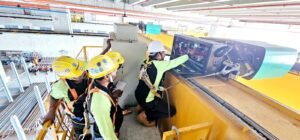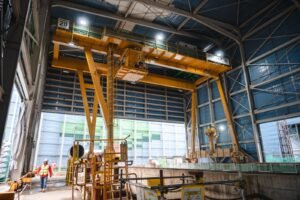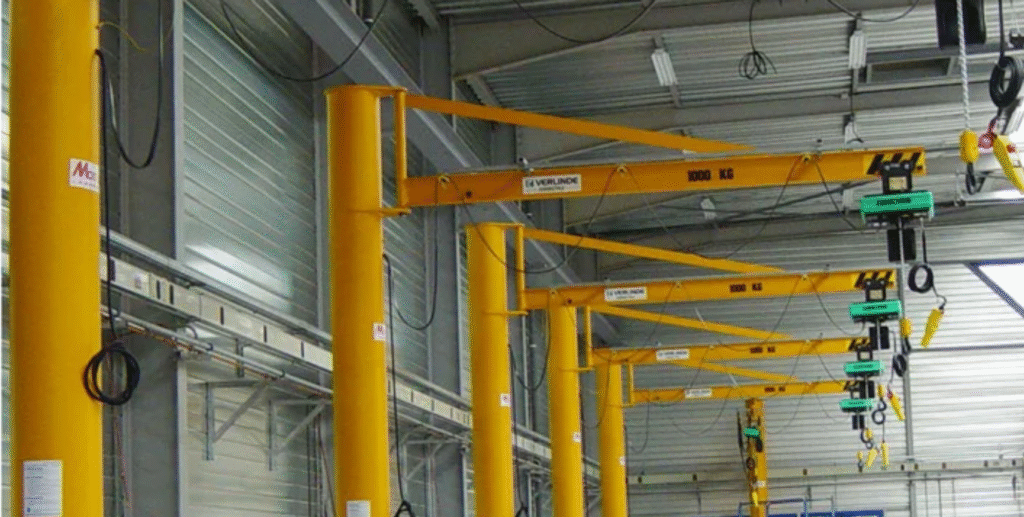Uncategorized
Pillar Jib Crane vs. Double Arm Jib Crane: What’s the Difference?
Jib cranes are widely used in many places as key machines for lifting. The machines are able to efficiently move materials between different work areas every single day. Being able to tell pillar jib cranes apart from double arm jib cranes helps you select the right device for your facility.
Selecting the right crane boosts your work efficiency and simplifies the moving of various materials. A good set of lifting equipment boosts your operations and helps you control your labour expenses.
What is a Pillar Jib Crane?
The design of a pillar jib crane includes a vertical mast and a motorised slewing arm, with outreach to hoist goods that the end user wants to lift. You’ll mount this crane type to a concrete base or base plate in the event the floor slab is too thin and unable to take the dead weight of the jib crane.
Customers can opt for 90-degree, 180-degree, 270-degree, and 360-degree slewing based on their needs. The crane ensures you can maximise your entire work area. You can pick between electric and manual hoists based on the lifting loads you have.
Overhead cranes have a lifting height of 6-20 metres, depending on the building height. Cranes in this category are suitable for lighter lifting items weighing from a few kilogrammes to 5 tonnes.
What is a Double Arm Jib Crane?
These cranes come with 2 outreach arms, mainly for the purpose of customers having workstations closely located with minimum workspace, and lifting of the two workstations is ongoing.
Thus, the jib arm is unable to be shared between the two workstations. You can choose wall mounted jib configurations or pillar-based mounting, depending on your facility layout.
Pillar Jib Crane vs. Double Arm Jib Crane: Key Differences
1. Structure and Design
A pillar jib crane has a single horizontal arm that comes from a main vertical tower, making it look like an L. You’ll find these cranes mounted to concrete bases or floor plates for independent operation.
Wall mounted jib options can only have one outreach arm. Your installation requirements depend heavily on which structural approach suits your facility’s constraints and load distribution needs.
2. Slewing and Motion
Pillar jib cranes offer a complete 360-degree slewing range when space permits full rotation. You control movement through manual or electric slewing systems based on your operational needs. Double arm jib cranes typically provide more limited slewing angles due to their dual-arm configuration.
The precise movement capabilities differ between crane types, with pillar designs offering smoother rotation. Electric slewing systems enhance control precision for both crane types. Your choice between manual and electric operation affects both initial costs and long-term operational efficiency throughout your facility.
3. Load Capacity and Reach
Standard load handling ranges vary considerably between pillar jib cranes and double arm models. Pillar jib cranes are designed to lift a wide range of load capacities, and their reach goes as high as 7 metres. Double arm jib cranes often accommodate different load distributions across their dual arms. The technical performance characteristics differ based on arm length and mounting configuration.
You’ll find pillar jib cranes excel at concentrated loads within their working radius. Double arm designs may offer advantages when handling multiple smaller loads simultaneously across their extended reach capabilities.
4. Space Requirements and Use Case
Pillar jib cranes work excellently in small or specific floor areas where 360-degree coverage maximises efficiency. You’ll install these cranes where floor space allows for the concrete base foundation requirements. Double arm jib cranes suit longer workspaces where their extended reach provides coverage advantages.
The space utilisation differs significantly between crane types based on your facility layout. Pillar designs require circular operating zones, whilst double arm cranes work well in rectangular or linear workspace configurations. Your space constraints ultimately determine which crane type delivers optimal material handling performance.
5. Productivity and Workflow
Pillar jib cranes improve material handling through complete rotational coverage of their work area. You’ll achieve better workflow efficiency when loads require movement in all directions around a central point. Double arm jib cranes enhance productivity in applications requiring simultaneous operations across multiple work zones.
The workflow benefits depend on your specific operational requirements and workspace layout. Pillar designs excel at feeding multiple workstations from a central position. Double arm cranes optimise linear production processes where materials flow along extended paths throughout your facility.
Installation Requirements and Considerations
Your concrete foundation must support the crane’s full load capacity plus dynamic forces during operation. Floor plate mounting requires proper anchoring to distribute loads evenly across the supporting structure. Mounting considerations include clearances for safe operation and maintenance access around the crane.
Height requirements vary based on your facility’s overhead obstructions and operational needs. You’ll need adequate clearance for hoist travel and load handling throughout the crane’s working range.
Choosing the Right Jib Crane for Your Needs
Assess your technical requirements by evaluating load weights, lifting frequencies, and operational precision needs. Consider your available space, including floor area, headroom, and clearance requirements around the crane. Your load handling needs determine whether single-point lifting or multi-zone coverage better suits your operations.
The installation process varies significantly between crane types, affecting both timeline and costs. You should evaluate long-term operational costs, including maintenance, energy consumption, and potential productivity gains. Professional consultation ensures you select the optimal crane solution for your specific application requirements.
Highlight: Jenmon’s Pillar Jib Crane Solutions
At Jenmon, we offer affordable and efficient handling equipment that fits seamlessly into your existing facility. Our pillar jib cranes offer compact designs whilst enabling load movement in every direction around your workstation. These cranes serve as ideal companions for overhead cranes, providing complete workshop coverage that increases autonomy and efficiency at every workstation.
Our pillar-mounted jib cranes mount onto columns with partial or full rotation capabilities. We anchor these cranes to the ground, making them completely independent from your building structure. Each crane serves work areas up to 360 degrees over spans reaching 7 metres.
Conclusion
Pillar jib cranes and double arm jib cranes serve different operational needs based on your facility’s requirements and space. Your choice depends on space constraints, load handling patterns, and workflow requirements. Both crane types offer significant advantages when properly matched to your application.
Assess your material handling needs carefully before making your final decision. Contact Jenmon today to discuss the right crane solution for your specific operational requirements and facility constraints.




